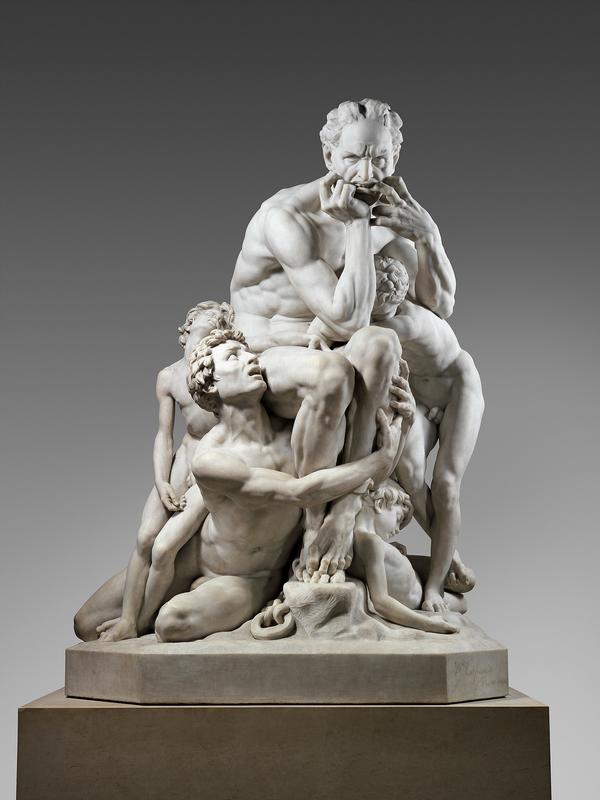More about Ugolino and His Sons

Contributor
Jean-Baptiste Carpeaux’s Ugolino and His Sons is a horror story to trump all other horror stories.
The largest figure with the twisted, angry face is Count Ugolino della Gherardesca, a real life Italian nobleman who is immortalized in Dante's Inferno. Dante puts Ugolino in the second ring of the lowest level of hell, which is reserved for traitors. This is apt, as before his banishment into the depths of hell, Ugolino enjoyed the life of a corrupt politician in Pisa, Italy.
Exiled from the city for suspicion of treason, Ugolino plotted with neighboring opposing forces to attack Pisa and reestablish his power. As king pin of Pisa, he became paranoid of other politicians, including his own nephew, destroying their palaces and ejecting them from the city (which seemed to be the go-to move around those parts in the Late Middle Ages). As Ugolino acted increasingly uncooperatively with the neighboring Genoa, a food shortage sparked riots amongst the townspeople and the opposition took their shot, violently overthrowing Ugolino. He was imprisoned for his dirty deeds along with his sons and grandsons, left in a tower to starve to death or resort to cannibalism after the keys were apparently thrown into the Arno river by his rival, the Archbishop.
It's in Dante's portrayal of Ugolino and his sons that Carpeaux finds his subject for this sculpture, painting a picture of grotesque suffering and despair. Dante describes Ugolino and the Archbishop trapped in ice up to their necks, with Ugolino gnawing at his enemy's skull. Though Carpeaux foregoes the head biting, the scene is still a major step away from the classical and Biblical figures students usually submitted to the French Academy in Rome, where Carpeaux studied. Some tried to deter him away from Count Ugolino and towards a more appropriate subject, but Carpeaux insisted that, “My mind always returns to my Ugolino.” Carpeaux looked to the Vatican’s famous Greek sculpture of Laocoon and His Sons for inspiration, and prepped with many sketches of malnourished kids to achieve the accuracy of starving bodies. (Oddly enough, one curator at the Met supposedly positioned this statue of Count Ugolino at the entrance to the snack bar, which is either very hilarious or wildly insensitive depending on your POV.)
Carpeaux isn’t the only artist transfixed by Dante's description of Ugolino's demise; Auguste Rodin, William Blake, Eugène Delacroix, Gustave Doré, and Joshua Reynolds have all depicted the man in his madness.
Sources
- Gibson, Eric, “The Human Clay,” Spectator USA, March 13, 2020. Accessed August 4, 2020. https://spectator.us/human-clay-sculpture/
- Jones, Jonathan, “Ugolino, Jean-Baptiste Carpeaux (1862), The Guardian, March 15, 2003. Accessed August 4, 2020. https://www.theguardian.com/culture/2003/mar/15/art
- Lombardi, Laura. From Realism to Art Nouveau. New York: Sterling Publishing Co., Inc., 2009.
- O’Neill, John P. Europe in the Age of Enlightenment and Revolution. New York: The Metropolitan Museum of Art, 1987.
- Edouard Papet, “Ugolino.” In The Passions of Jean-Baptiste Carpeaux, edited by James David Draper and Edouard Papet, 66-95. New Haven: Yale University Press, 2014.
- Pyle, Eric. Willian Blake’s Illustrations for Dante’s Divine Comedy: A Study of the Engravings, Pencil Sketches and Watercolors. Jefferson, NC: McFarland and Company, Inc., Publishers, 2015.
- Smith, Roberta, “Tortured Soul, Golden Touch,” The New York Times, March 27, 2014. Accessed August 4, 2020. https://www.nytimes.com/2014/03/28/arts/design/jean-baptiste-carpeaux-a…
Featured Content
Here is what Wikipedia says about Ugolino and His Sons (Carpeaux)
Ugolino and His Sons is a marble sculpture of Ugolino made by Jean-Baptiste Carpeaux in Paris during the 1860s. It depicts the story of Ugolino from Dante's Inferno in which the 13th century count is imprisoned and starving with his children. The work, known for its expressive detail, launched Carpeaux's career.
Check out the full Wikipedia article about Ugolino and His Sons (Carpeaux)












